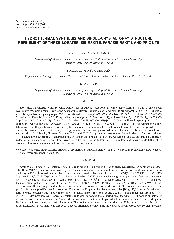摘要
Sibirskite, parasibirskite and priceite, synthesized in aqueous solutions at temperatures from 80 to 240 degrees C, have been investigated by single-crystal X-ray refinements of the structure. Sibirskite and parasibirskite are dimorphs of CaHBO(3). Sibirskite at 295 K crystallizes in space group P12(1)/c1(no. 14), with a 3.5624(7), b 9.5225(19), c 8.6231(17) angstrom, beta 119.452(3)degrees, V 254.72(9) angstrom(3), and Z = 4. Parasibirskite at 295 K crystallizes in space group P12(1)/m1(no. 11), with a 6.6994(13), b 5.4269(11), c 3.5534(7) angstrom, beta 93.048(11)degrees, V 129.01(5) angstrom(3), and Z = 2. Priceite, (Ca(2)(H(2)O)[B(5)O(7)(OH)(5)]), at 173 K crystallizes in space group of P12(1)/c1 (no. 14), with a 11.580(3), b 6.9844(19), c 12.352(3) angstrom, beta 110.573(9)degrees, V 935.3(4) angstrom(3), and Z = 4. Our refinements allow determination of the positions of boron and hydrogen atoms in these minerals, which was not possible in previous powder XRD studies. In particular, the isolated [BO(2)(OH)] groups in sibirskite and parasibirskite are characterized by a long B-OH bond and two short B-O bonds, different from the [BO(3)] and [B(OH(3))] groups in nesoborates. Periodic density functional theory (DFT) calculations for sibirskite and parasibirskite support those results of structure refinements and suggest that parasibirskite undergoes a displacive phase-transition involving hydrogen ordering below 173 K. Sibirskite and parasibirskite left in their parental solutions at ambient conditions decompose to form calcite.
- 出版日期2011-6
- 单位厦门大学; Saskatoon
